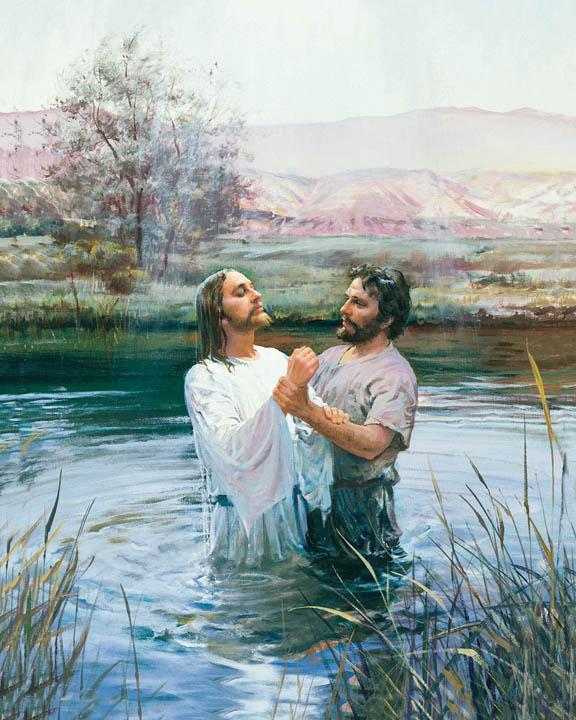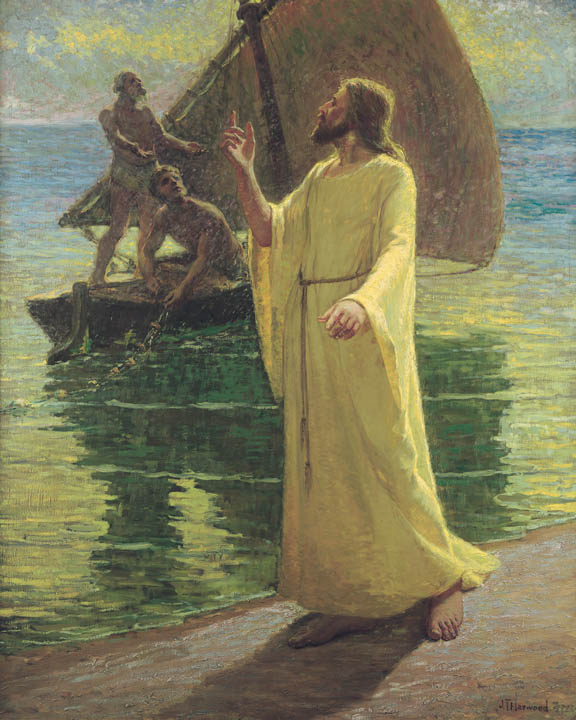 Jesus went to John the Baptist to be baptized. In this event, we see evidence of the Father, the Son, and the Holy Ghost as three distinct beings, the Father speaking from heaven, the Son in the waters of baptism, and the Holy Ghost in the form of a dove. Many had gathered to hear the teachings of the Baptist, among them the Galilean fisherman Jesus called as the first of His apostle — Andrew; and then Peter; then Phillip and Nathanael.
Jesus went to John the Baptist to be baptized. In this event, we see evidence of the Father, the Son, and the Holy Ghost as three distinct beings, the Father speaking from heaven, the Son in the waters of baptism, and the Holy Ghost in the form of a dove. Many had gathered to hear the teachings of the Baptist, among them the Galilean fisherman Jesus called as the first of His apostle — Andrew; and then Peter; then Phillip and Nathanael.
Jesus performed His first recorded private miracle in Cana of Galilee (John 2). Mary, His mother, reported to Him that there was only water, no wine, and Jesus changed the water to wine.
Jesus Christ’s formal holy land ministry lasted three years. His public ministry began and ended with Passover, full of imagery of the Savior’s ministry and identity as Messiah. Jesus went to Jerusalem after His miracle in Cana, and after having visited Capernaum. Passover was one of the three pilgrimage festivals of the Jewish year, and probably the most popular, with over a million Jews coming to Jerusalem to worship and sacrifice at the temple. As with any festival, extraneous cultural traditions accrue year to year, and by Jesus’ time, there was a carnival atmosphere around the temple.
As recorded in John 2:13–22, Jesus defended the sanctity of His Father’s house. He overturned the money changer’s tables, and said to the sellers of doves, ‘Take these things hence. Make not my Father’s house a house of merchandise.’ [ John 2:16 .] Afterwards, Jesus made His famous prophecy that if the temple should be destroyed, He could raise it up in three days. No one understood that He meant the temple of His body, which would be resurrected after 3 days in the tomb.
Jesus then had a conversation with Nicodemus, a Pharisee, and explained to him that a person must be “born again” to enter the kingdom of God. Jesus and His disciples then went to Judea to baptize. [The Joseph Smith Translation says that Jesus baptized, while the King James says that only the disciples baptized.] John the Baptist was also baptizing there. John explained that he must “decrease,” while the Savior would “increase.” (Modern prophets have informed us that John the Baptist wrote a great deal, but that men are not yet worthy to receive his writings.)
Jesus then traveled through Samaria on His way to Galilee. Most Jews skirted Samaria to avoid traveling through it. The Samaritans were hated by the Jews partly for their impure lineage, though they claimed to be Israelites, their habit of performing sacrifices in “unholy” places, and their only-partial use of the scriptures or partial acceptance of Jewish traditional religion. The Samaritans had fought against the building of the second temple, also.
In Samaria, Jesus encountered the “woman at the well.” (See John 4:9.) He saw into her heart and her life, to the point that she was converted. When she spread the news of the Messiah to her kinsfolk, they were also converted. In this story, we are introduced to Christ as the “living water.”
“His solemn invitation, ‘If any man thirst, let him come unto me, and drink,’ was a plain and open claim of Messiahship. In making it he identified himself as the very Jehovah who had promised drink to the thirsty through an outpouring of the Spirit. After such a pronouncement his hearers were faced with two choices: Either he was a blasphemer worthy of death, or he was in fact the God of Israel.” (McConkie, New Testament Commentary, 1:445–46.)
Returning to Nazareth, the place of his boyhood and early manhood, Jesus astonished the townsmen with his bold testimony that he was the promised Messiah. Using Isaiah 61:1, 2 as his text, Jesus declared in the synagogue: “The Spirit of the Lord God is upon me; because the Lord hath anointed me to preach good tidings unto the meek; he hath sent me to bind up the brokenhearted, to proclaim liberty to the captives, and the opening of the prison to them that are bound; To proclaim the acceptable year of the Lord, and the day of vengeance of our God; to comfort all that mourn.” As Jesus closed the book containing these words, He said: “This day is this scripture fulfilled in your ears.” ( Luke 4:21 .)
The result of this act was that people of the congregation rose up and attempted to kill Him. The Lord had spent two thousand years preparing this very people to receive the Christ, and the second He manifested Himself and declared His ministry, they wanted to do away with Him. When the pattern of worship overtakes the spirit of worship, the Holy Spirit is unable to get through to testify to the truth. The men in the synagogue considered themselves God’s Chosen, and yet, they could not recognize His voice. There is a particular irony here. One may assume that the Jewish hero was Moses, but that’s not true. The Jewish heroic figure has always been David (and continues to be). David was a humble shepherd in the beginning and rose to be a great king and prophet. Now, in Nazareth, Jesus was a poor carpenter’s son. Having remodeled their expected Messiah into the image of David, the Jews could not now believe that a humble local son could be the Messiah; yet David had the same, humble beginnings.
 In Matthew we have an account of the fishermen/apostles leaving their nets in order to follow Jesus. Their belief, their spiritual witness that Christ was who He claimed to be, enabled them to drop everything and follow Him (Matthew 4).
In Matthew we have an account of the fishermen/apostles leaving their nets in order to follow Jesus. Their belief, their spiritual witness that Christ was who He claimed to be, enabled them to drop everything and follow Him (Matthew 4).
In Mark 1, we have an account of Jesus casting out devils. Members of The Church of Jesus Christ of Latter-day Saints believe that we all existed as spirits in a pre-existent realm before we were born into mortality on earth. There was a war in heaven between good and evil, and Lucifer (who became the devil) and his followers were cast out. Their progress stopped at that point. They would never obtain physical bodies, but would remain spirits for eternity. Because there was a pre-existence, and the memory of these spirits had not been veiled by physical bodies, they remembered the identity of Jesus Christ. They knew Him on earth, because they knew Him in the pre-existence.
Jesus Christ was now fully engaged healing the minds, bodies and spirits of those who believed in Him. He showed that He not only had the power to heal the body, but to forgive people of their sins. To Jewish leaders, this was blasphemy, for only God could forgive sins.
Jesus called Matthew, a publican, to be an apostle. Publicans were despised by the Jews, for they were tax collectors for the Romans. Publicans made a profit off the collection of taxes, charging a commission they set for themselves. Matthew served honestly in his profession, however, and Jesus saw his integrity.
New Wine in Old Bottles?
“In such wise did our Lord proclaim the newness and completeness of His gospel. It was in no sense a patching up of Judaism. He had not come to mend old and torn garments; the cloth He provided was new, and to sew it on the old would be but to tear afresh the threadbare fabric and leave a more unsightly rent than at first. Or to change the figure, new wine could not safely be entrusted to old bottles. The bottles here referred to were really bags, made of the skins of animals, and of course they deteriorated with age. Just as old leather splits or tears under even slight strain, so the old bottle-skins would burst from the pressure of fermenting juice, and the good wine would be lost. The gospel taught by Christ was a new revelation, superseding the past, and marking the fulfilment of the law; it was no mere addendum, nor was it a reenactment of past requirements; it embodied a new and an everlasting covenant. Attempts to patch the Judaistic robe of traditionalism with the new fabric of the covenant could result in nothing more sightly than a rending of the fabric. The new wine of the gospel could not be held in the old time-worn containers of Mosaic libations. Judaism would be belittled and Christianity perverted by any such incongruous association.” (Talmage, Jesus the Christ, pp. 196–97.)
Have Miracles Ceased?
All the miracles performed in Christ’s ancient church are alive and well today and found in full flower in The Church of Jesus Christ of Latter-day Saints. These are common and private, but enrich the lives of the “Saints,” and heal and protect them. Prophet Harold B. Lee gave one account:
“May I impose upon you for a moment to express appreciation for something that happened to me some time ago, years ago. I was suffering from an ulcer condition that was becoming worse and worse. We had been touring a mission; my wife, Joan, and I were impressed the next morning that we should get home as quickly as possibly, although we had planned to stay for some other meetings.
“On the way across the country, we were sitting in the forward section of the airplane. Some of our Church members were in the next section. As we approached a certain point en route, someone laid his hand upon my head. I looked up: I could see no one. That happened again before we arrived home, again with the same experience. Who it was, by what means or what medium, I may never know, except I knew that I was receiving a blessing that I came a few hours later to know I needed most desperately.
“As soon as we arrived home, my wife very anxiously called the doctor. It was now about 11 o’clock at night. He called me to come to the telephone, and he asked me how I was; and I said, ‘Well, I am very tired. I think I will be all right.’ But shortly thereafter, there came massive hemorrhages which, had they occurred while we were in flight, I wouldn’t be here today talking about it.
“I know that there are powers divine that reach out when all other help is not available. We see that manifest down in the countries we speak of as the underprivileged countries where there is little medical aid and perhaps no hospitals. If you want to hear of great miracles among these humble people with simple faith, you will see it among them when they are left to themselves. Yes, I know that there are such powers.” ( Harold B. Lee, “Stand Ye in Holy Places,” Ensign, July 1973, p. 123 . Italics added.)
Parts of this article have been adapted from the LDS Institute New Testament Manual.
